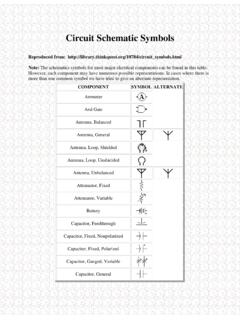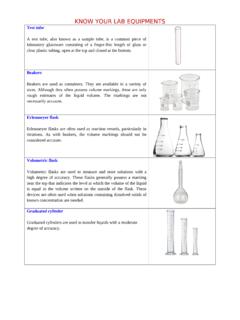Transcription of Lab 8: Buoyancy and Archimedes Principle
1 Lab 8: Buoyancy and Archimedes PrincipleDescriptionIn this lab, you will explore the force that displacing a fluid (liquid or gas) will exert on thebody displacing the fluid. You will study how the balance of forces between weight of the objectand the Buoyancy force on the object allow objects to Graduated cylinder Triple Beam Balance Metal cylinder Wood cylinder Ruler, Meter stick, or Vernier Calipers Ring StandIntroductionArchimedes Principle states: the buoyant force on a body in a fluid is equal to theweight of the fluid displaced by the body. We will examine this Principle in todays laboratoryfor objects that sink and objects that float when immersed in a we have an object of mass m and volume V, its density (the Greek lower case letter rho) isgiven by: =mV(1)If the object is in a vacuum or, for our purposes, air, its weight, w, will be equal to mg, whereg is the acceleration due to gravity.
2 In this experiment we will consider two objects. The first willbe more dense than the fluid in which it is to be submerged, and the second will be less dense thanthe fluid in which it is to be submerged. If the first object is weighed when immersed in the fluid, itwill have an apparent weight,w =m g, where m is its apparent mass. According to Archimedesprinciple (see Appendix E: A Detailed Explanation of Buoyancy ), we can write the equation:m g m g=mf g(2)The difference in the weight of the object out of the fluid and the weightof the object whileimmersed in the fluid is equal to the weight of the fluid displaced,mf g, wheremfis the mass ofthe fluid the fluid has a density, f=mfVf, we can substitute f Vfformfand obtain:m g m g= f Vf g(3)51 However, since the volume if the fluid displaced is equal to the volume of the submerged object,we can replaceVfwithm from Equation g m g= f m g(4)Diving both sides by g, and solving for , we get.
3 = f mm m (5)Therefore, if we have a fluid of known density, and we can measure themass of the object, m,and its apparent mass while immersed in the fluid, m, we can use Archimedes Principle to find theobject s the object is less dense than the fluid, it will float, only partiallysubmerged in the according to Archimedes Principle , the buoyant force must be equal to the weight of thefluid displaced:m g=mf g(6)wheremfis the mass of fluid displaced. Notice that you can prove this equation if you insertm = 0 in Equation 2. This is equivalent to an apparent mass, as measured on thespring scale orbalance, of zero. IfVuis the part of the object s volume under the fluid, then:mf= f Vu(7)This expression and Equation 1,m=V , reduces Equation 5 to:mf= f Vu(8)Dividing both sides of this equation by g and rearranging terms gives: = f VuV(9)The density of the object is equal to the fraction of its volume submerged times the density ofthe gravity, S, is often used to characterize an object s density with respectto the densityof water.
4 We may express this as:S= f(10)In all cases examined here, the fluid is assumed to be pure water ( f ). Notice thatS is a unit-less quantity, since the units of the densities cancel. Also, a body s specific gravitycharacterizes whether it will sink or float. This can be summarized by: If S 1: the object will sink If S=1: the object is neutral Buoyancy If S 1: the object will float52 Figure 1: The Buoyancy : Standard values of density may be found in Appendix E for analyzing specific Verify Archimedes Principle by using a graduated cylinder or beaker to determine how muchwater is displaced by the small metal cylinder provided. Read the level of the water beforeand after the object is submerged and determine the amount of water displaced. Assumingthe density of water to be 1g/cm3, calculate the weight of the water which is displaced.
5 Usethe scale to determine the mass of the metal cylinder and its apparentmass when submergedin water. Find the buoyant force supplied by the water and compare to the weight of thewater displaced. (Do your results verify Archimedes Principle ?)2. Use Archimedes Principle to determine the density of the metal Use the ruler, meter stick, or vernier calipers provided to determine the length and diameterof the cylinder . Determine the mass of the cylinder and calculate the density. Note: thevolume of a cylinder is given by:V=L r2where L is the cylinder s length and r is Compare the results of the two methods. Find the percent Verify Archimedes Principle for the small wood cylinder . Read the level of the water beforeand after the object is placed in the water. This change in volume is equal to the volumeof wood under the water,Vu.
6 Using the density of water given above, calculate the weightof the water displaced and compare it to the weight of the wood. (Do your results verifyArchimedes Principle ?)6. Use Archimedes Principle to determine the density of the wood sample. Determine the fraction53of the volume submerged by measuring the fraction of the cylinder s length under water orby using the answer forVufound in step 5 and calculating the full volume fromV=L of Caution: Remember to convert units to MKS to perform If you had a plastic rod, do you think it would float, sink, or remain suspended in water?Why?2. Archimedes Principle states that a buoyant force is exerted on a body which is immersed ina fluid. A fluid can be either a liquid or a gas. Qualitatively, how mucherror is introducedin this lab by treating air as if it were a vacuum?
7 Is this significant when compared with theaccuracy of the measuring devices used?3. How may Archimedes Principle be related to aviation or your degree program? Provide arelevant example of Archimedes E: A Detailed Explanation of BuoyancyFigure 2: A free body diagram of the a body of mass m immersed completely in a fluid. The body issuspended by a light(massless) string from a triple beam balance or spring scale (depicted here for simplicity). Thebody is in static may apply Newton s 2ndLaw to both the submerged body and the spring scale (hereassumed to be the scale s hook). The figure depicts both free body the upper FBD, a tension forcevecT(due to the string) pulls down and is balanced bythe Hooke s Law-type forcevecFHin the spring scale (that is how a spring scale works and iscalibrated). Since these forces are equal in magnitude and opposite in direction, the net forceequals zero.
8 Thus, the spring scale/string is in static lower FBD depicts the applied forces for the submerged mass. This mass is also in staticequilibrium. The weightvecWof the body is balanced by two forces: the tensionvecTin the stringand the buoyant forcevecFB. If we apply Newton s 2ndLaw in the vertical direction, then:n i~Fi=~Fnet(11)where n is the number of the forces F applied to the body (hence, the applied forces or the cause ) and Fnet is the net force (the effect actually observed). In this case,~W+~T+~FB=~Fnet= 0(12)55If up is defined arbitrarily to be the positive direction and down is treated as being the negative direction and we indicate direction by sign, then: W+T+FB= 0(13)orW T=FB(14)SinceW=mg, the tension in the string ism g(as indicated by the spring scale/balance), andaccording to Archimedes Principle ,FB=Wf=mf g; thus, Equation 2 is 3: Table obtained from Handbook of Chemistry and Physics Weast 53rd Edition





